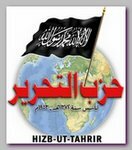– HIZB-UT-TAHRIR AL-ISLAMI
 Hizb-Ut-Tahrir al-Islami (The Islamic Liberation Party) was founded in the Jordanian-ruled part of Jerusalem in 1953 by an appeals court judge, Taqiuddin al Nabhani and started to carry the da’wah (repentance) within some of the Arab countries, especially Jordan and Saudi Arabia. The Hizb-Ut-Tahrir al-Islami emerged due to the profound influence of the Muslims Brotherhood in Egypt on all the Muslims in the Muslim world.
Hizb-Ut-Tahrir al-Islami (The Islamic Liberation Party) was founded in the Jordanian-ruled part of Jerusalem in 1953 by an appeals court judge, Taqiuddin al Nabhani and started to carry the da’wah (repentance) within some of the Arab countries, especially Jordan and Saudi Arabia. The Hizb-Ut-Tahrir al-Islami emerged due to the profound influence of the Muslims Brotherhood in Egypt on all the Muslims in the Muslim world.
The goal of Hizb-Ut-Tahrir al-Islami is the – “‘implementation of pure Islamic doctrine and the creation of an Islamic caliphate” and is to resume the Islamic way of life, Islamic law (Shariaa) and to convey the Islamic da’wah (repentance) to the world.
Hizb-Ut-Tahrir – believes it can achieve its utopian Islamic state in three steps. The first involves educating Muslims about its philosophies and goals. In the second step, the Muslims would then spread these views among others in their countries, especially members of government, the military and other power centers. In the third and final step, Hizb ut-Tahrir believes its faithful will cause secular governments to crumble because loyalties will then lie solely with Islam – not nationalities, politics or ethnic identifications. At that point the group says a supreme Islamic leader, a Caliph, like those of the first century of Islam would rule all Muslims with both political and religious authority.
The main method of action of Hizb-Ut-Tahrir was a network of da’wah classes and preachers in order to reach out, mainly to youngsters, and convinced them to return to the values of Islam. Originally Hizb-Ut-Tahrir denounced any sort of violence as a legitimate mean.
Soon Hizb-Ut-Tahrir members were persecuted by almost all Arab rulers. Dozens of Hizb-Ut-Tahrir members were killed and many hundreds jailed. Because of persecutions in the Arab world and the Soviet block in the 60s’ and the 70s’, Hizb ut-Tahrir main base was in Western Europe, but it has large followings in Uzbekistan, Tajikistan, Kyrgyzstan, and Kazakhstan, as well as in China’s traditionally Muslim Xinjiang (Turkistan) Province. Most of its members in the last years are believed to be ethnic Uzbeks.
Its expansion into Central Asia coincided with the breakup of the Soviet Union in the early 1990s. By one estimate there are more than 10,000 followers in Central Asia.
The United States Government is continuing to monitor Hizb ut-Tahrir. Despite the statements of governments of the region, the United States has found no clear ties between Hizb ut-Tahrir and terrorist activity. Hizb ut -Tahrir has not been proven to have involvement in or direct links to any recent acts of violence or terrorism. Nor has it been proven to give financial support to other groups engaged in terrorism. Because of that, it falls outside the definitions used by the United States and others to designate a terrorist group.
Hizb-Ut-Tahrir al-Islami was and is an Islamic alternative both political and social to the secular post communist corrupted dictatorships of Central Asia and a source of social unrest and is therefore blamed by the local regimes of terror, especially after The 9/11 when labeling an Islamic group as an Al Qaeda affiliated terror group was automatically supported by USA and helps to achieve American military aid and military assistance.
The persecution of Hizb-Ut-Tahrir members all over central Asia brought, in return, many members to adopt an underground lifestyle, to join Islamic militant groups in Asia or to form their own underground and militant organizations such as the “Islamic Movement of UZBEKISTAN” –IMU or the the “Islamic Jihad Union” –IJU.
In 02/2003, the Russian Supreme Court put Hizb ut-Tahrir and 14 other groups on a list of banned terrorist organizations. A month before, Hizb ut-Tahrir was outlawed in Germany on charges of anti-Semitism and anti-Israeli propaganda.
In 06/06/2003 Russia’s Federal Security Service (FSB) arrested 121 illegal immigrants suspected of having ties with Hizb ut-Tahrir al-Islami. Among the detainees were Alisher Musayev of Kyrgyzstan and Akram Jalolov of Tajikistan, whom the FSB suspected of being the leaders of the dismantled cell. Moscow media reports said hand grenades, explosives, and ammunition were found on both men, as well as Islamic propaganda leaflets. The FSB said the arrests had uncovered the tip of the iceberg and claimed Hizb ut-Tahrir has a network of cells covering all of Russia. Most of the detainees were Central Asians, although there were some Slavs and Arabs among them.
Founder Taqiuddin al Nabhani died in 1977 and was succeeded by Abd al-Qadim Zallum who was succeeded in turn by Ata abu-Rashta when Zallum died in 2003.
Today (08/2008) Hizb ut-Tahrir al-Islami poses, still, a stiff ideological opposition to USA and Western influence in Central Asia also officially banned by law – similar to the status and influence of the Muslims Brotherhood in Egypt and the Middle East.
* Related topics –
-
PROFILE -REZA PANKHURST & MAAJID NAWAZ
PROFILE -IMAM FAISAL ABDUL RAUF
THE ISLAMID FORUME OF EUROPE – I.F.E
**********0**********
Read more ;